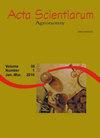巴西不同矿物学土壤中磷组分及其与磷酸盐缓冲能力指标的关系
IF 1.2
4区 农林科学
Q3 AGRONOMY
引用次数: 1
摘要
在热带地区,由于磷肥的施用效率较低,磷是土壤施肥中最重要的元素之一。本研究旨在对不同矿物学组成的热带土壤中无机磷(Pi)进行分馏,并将这些分馏与它们各自的磷酸盐缓冲能力(PBC)指标联系起来。对土壤进行了物理、化学和矿物学表征。此外,我们还评估了达到平衡后土壤溶液中剩余磷的浓度;这被称为P余量(P-rem)。总体而言,土壤的Pi分数与PBC指标不相关。P-H2O分数与P-Al分数呈负相关。铁矿物不影响固磷作用。P-rem与Fe的最大吸附量、吸附能、非晶态和结晶态密切相关。铝矿物对固磷的贡献最大。P-rem是PBC的最佳估计值。高、中、低固磷率土壤P- al、P- ca、P- fe含量均较高。结果表明,土壤中磷的固定受磷组分的影响,表明热带土壤中磷肥的效率取决于土壤中粘土组分的矿物学特征。本文章由计算机程序翻译,如有差异,请以英文原文为准。
Phosphorus fractions in soils with distinct mineralogy and their relationship with phosphate buffer capacity indicators in Brazil
Phosphorus (P) is one of the most important elements used in fertilizing soils in tropical regions due to the low efficiency of phosphate fertilization. This work aimed to fractionate inorganic P (Pi) in tropical soils of different mineralogical compositions and to relate these fractions with their respective phosphate buffer capacity (PBC) indicators. The soils were characterized physically, chemically and mineralogically. Additionally, we evaluated the P concentration that remained in solution of soil after equilibrium was met; this was termed P remaining (P-rem). In general, the Pi fractions of soils did not correlate with the PBC indicators. The P-H2O fraction showed a negative correlation with the P-Al fraction. Ferric minerals did not influence P fixation. P-rem showed a strong correlation with the maximum P adsorption capacity, adsorption energy, and the amorphous and crystalline forms of Fe. The minerals of aluminum contributed the most to P fixation. P-rem was the best estimator of PBC. The soils with high, moderate and low rates of P fixation showed high amounts of the fractions P-Al, P-Ca, and P-Fe, respectively. The results showed that P fixation was influenced by the fractions of P in the soil, suggesting that the efficiency of phosphate fertilizers in tropical soils depends on the mineralogy of the clay fraction within those soils.
求助全文
通过发布文献求助,成功后即可免费获取论文全文。
去求助
来源期刊

Acta Scientiarum. Agronomy.
Agricultural and Biological Sciences-Agronomy and Crop Science
CiteScore
2.40
自引率
0.00%
发文量
45
审稿时长
>12 weeks
期刊介绍:
The journal publishes original articles in all areas of Agronomy, including soil sciences, agricultural entomology, soil fertility and manuring, soil physics, physiology of cultivated plants, phytopathology, phyto-health, phytotechny, genesis, morphology and soil classification, management and conservation of soil, integrated management of plant pests, vegetal improvement, agricultural microbiology, agricultural parasitology, production and processing of seeds.
 求助内容:
求助内容: 应助结果提醒方式:
应助结果提醒方式:


